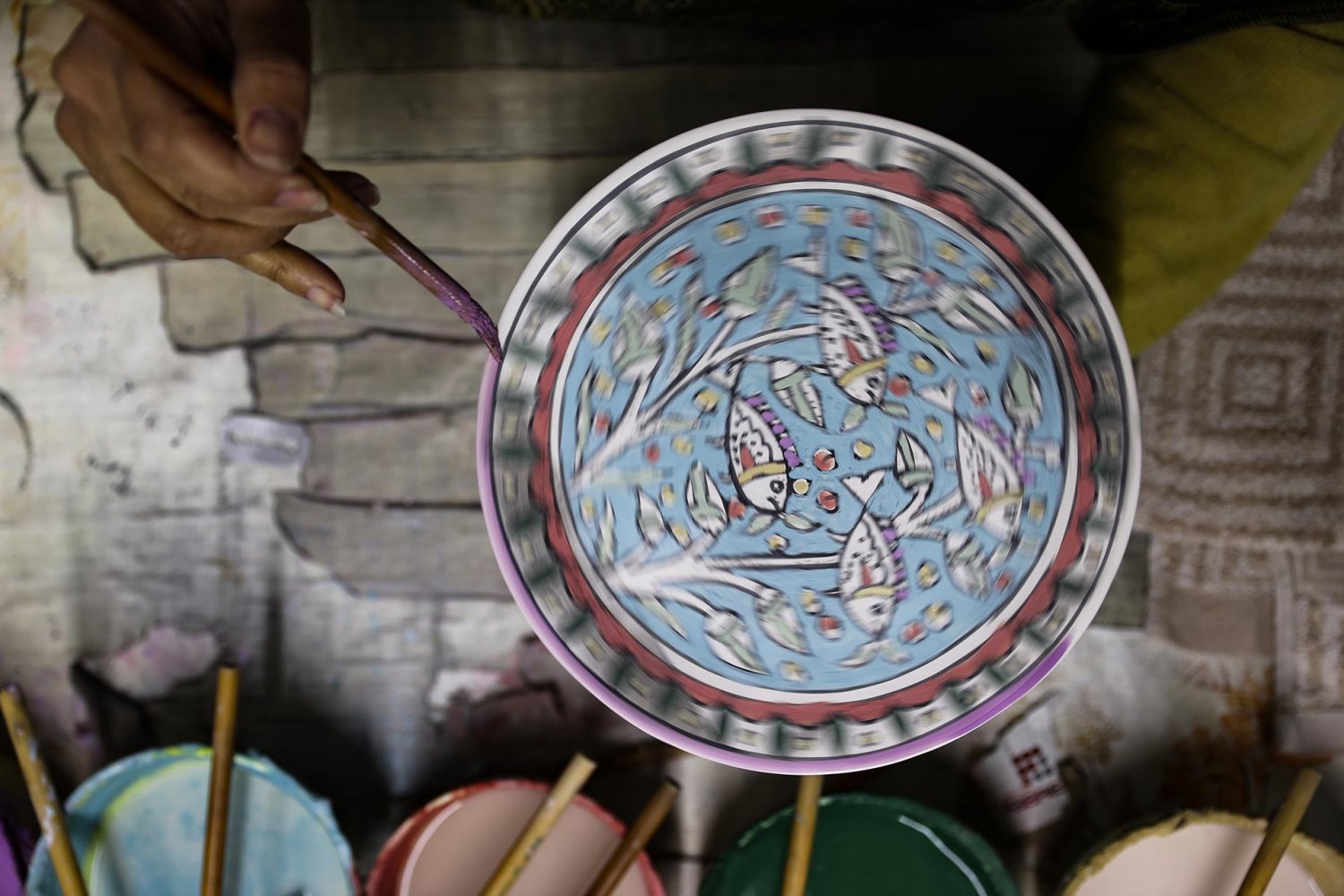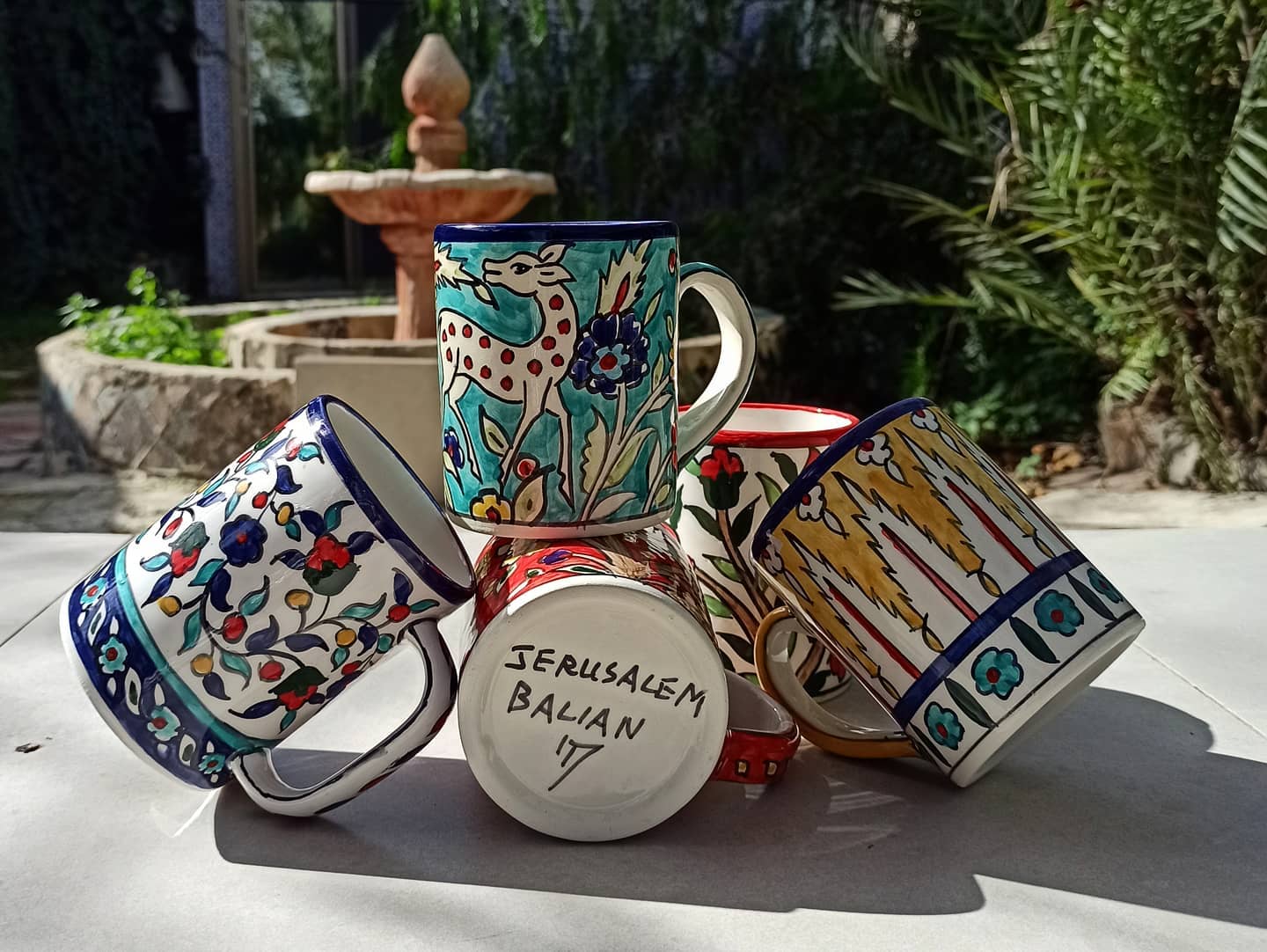Neshan Balian Jr., the owner of the Balian studio and grandson of Neshan Balian Sr., who first established it in 1922 after arriving in Jerusalem from Kütahya, Turkey, a few years earlier
Credit:
Mustafa al-Kharouf for Jerusalem Story

Credit:
Mustafa al-Kharouf for Jerusalem Story
Introduction
In autumn of 1919, Neshan Balian Sr. was one of two ceramic artists specially brought to Jerusalem from Kütahya, Turkey, a major center of ceramic artistry at that time. He and Mgerdich Karakashian were recruited by another Armenian, David Ohannessian, an artist who had been commissioned and brought to Jerusalem by the British to refurbish the ceramic tile on the dome of al-Aqsa Mosque. The original tiles, which had been made in Turkey in the 16th century under the Ottoman Empire, were degrading, some even to the point of falling off, in the wake of an earthquake.
The first British military governor of Jerusalem, Ronald Storrs, cast about for a suitable artist to refurbish the tiles and recalled that he had seen similar tiles in the home of Mark Sykes, a British officer and MP,1 in Yorkshire, England. Those tiles had been custom designed and installed by Ohannessian, an Armenian ceramic artist who had completed many works of art for prestigious clients worldwide. By chance, Storrs came across Ohannessian in Syria, where he had managed to flee with his family from the Armenian genocide, enduring a barely survivable brutal journey as refugees.
The three Armenians came and reopened the pottery workshop at the mosque that had been used to produce the original tiles hundreds of years earlier. They even found kilns from the 16th century waiting to be reignited.
Things did not go as planned, however. The kilns would not operate. Raw materials they needed were impossible to import from Kütahya as the Armenian genocide had spread there. The thickness of the 16th-century tiles was hard to match. And there were other problems. In the end, the funds ran out and the commission was canceled, but the three ceramicists remained in Jerusalem and in 1922, a century ago, two of them, Balian and Mgerdich Karakashian, opened their own workshop on Nablus Road.
At this workshop, the families built on the unique and iconic Kütahya style of pottery that they had brought with them (which derived from the historic Iznik style that preceded it, and even before that, Persian influences that were brought to Turkey in the 13th century), adding to it style elements from Armenian and Palestinian art: “Turkish and Palestinian designs have geometric patterns; many of the Persian pieces are decorated with floral motifs; Armenian designs feature animals.”2
In 1965, the founding partnership came to an end, and the Balian family continued as the sole proprietors of the historic design studio while the Karakashian family opened their own studio elsewhere in the city.
This Balian design studio, still flourishing today, is now run by Balian Sr.’s grandson, Neshan Balian Jr., who has degrees in ceramic and mechanical engineering from Ohio University in the US. His children, the fourth generation, are also learning the craft and becoming involved.
Today the firm employs 13 potters and painters—Arab and Armenian, Muslim and Christian. From the beginning the work was premised on a multicultural ethos that did not differentiate between religions, nationalities, or any other grouping.
This design studio and workshop is a favorite of Jerusalem photographer Mustafa al-Kharouf, who visited recently to capture the soul of the place through his lens for this story.
These are his images, accompanied by his commentary.
In the Eyes of the Beholder
This place is like no other in Jerusalem. It’s distinguished by integrating the Palestinian/Islamic and Armenian art in manufacturing all the traditional pottery shown in the photos.
This place is considered to be the oldest shop/factory in Jerusalem and even in Palestine as a whole.
This place has a unique history. When I visit, the art I see takes me back in time 100 years toward the end of the Ottoman Empire. I consider this as one of the most important places in Jerusalem because it still preserves its Armenian/Palestinian identity after all this time.
I am a person who loves art, especially painting, and visiting this place enriches me visually every time I come. I feel internally connected to this art.
In my view, the place is also distinguished by the fact that the owners are Armenian Christians, but they employ Muslim Palestinian artists for the ceramic production. Their outlook has historically always been very open and inclusive.
The Workshop
The workshop is where the artistry happens. It has four rooms:
The pieces are hand-painted with ceramic oxides then fired to a temperature of about 1,000 centigrade for maximum durability of colors and glaze.
All authentic Balian pieces are signed with the trademark Balian “Պ” (the letter B in Armenian) and the place of origin, Jerusalem. This is how you can determine a genuine hand-painted Balian work of art from a cheap machine-made forgery.
The day I visited, I was fortunate that ceramic artists allowed me to observe their meticulous work as they decorated, painted, glazed, and fired plates and tiles.
The Authentic Balian Signature

Source: Balian Armenian Ceramics of Jerusalem Facebook page
The signature that differentiates the true Balian piece from the forged fake ones.
The Gallery Shop
The Balian design studio has a shop where finished works for sale are on display. Here are a few of the stunning pieces that particularly caught my eye on the day that I visited.
The Museum
The Museum at the Balian studio showcases important historic art pieces from a centennial of Armenian pottery artistry in Jerusalem.
This includes historic pieces such as a custom designed, hand-painted Armenian Coat of Arms created at the workshop of Balian Sr. and Karakashian in the 1930s, before they split to form their own separate workshops. That historic piece is one of only two known copies; the second one is on display at the Dzidzernagapert Genocide Museum in Armenia.
Every piece on display in the museum has a story behind it.
For more information and to order ceramics, visit the Balian ceramics shop in East Jerusalem at 75 Nablus Road or online here.
This is the same Mark Sykes of the Sykes–Picot Agreement of 1916.
“Tales of Tiles,” The Irish Times, February 13, 1999.